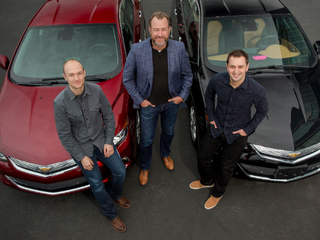It’s confirmed.
Lyft announced this morning the closing of a $1 billion Series F round of funding, doubling the company’s total funding to just over $2 billion. The company is now valued at $5.5 billion, ranking it above its partner in India, OlaCabs (valued at $5 billion), but still far away from Didi Kuaidi (valued at $15 billion) and Uber (reportedly valued as high as $62.5 billion).

The company’s newest big investor is General Motors (GM), the American car company whose brands include Chevrolet, Buick, GMC, and Cadillac. GM contributed $500 million toward the round, Kingdom Holding Company contributed $100 million and its affiiliates contributed another $150 million. Other participants included new and existing investors including Janus Capital Management, Rakuten, Didi Kuaidi, and Alibaba.
Along with the half billion dollar investment, GM is working with Lyft on a new “Autonomous On-Demand Network,” combining the car company’s developments in autonomous vehicles with Lyft’s software for ride matching, routes, and payments.
Though the company’s announcement says they’re working with GM to make this network “part of people’s daily lives,” it’s unclear what that means for the year ahead. As I said in my 2016 predictions piece last week, several legal and technological barriers mean we won’t likely see fully-autonomous cars on the road this year.
We reached out to the company to learn more details about the “Autonomous On-Demand Network,” but they wouldn’t disclose any details around timing.
That said, it’s clearly beneficial for Lyft to invest in this technology since managing drivers has proven one of the company’s biggest hurdles. On a foundational level, drivers are just another expense. On a more complex level, more and more drivers are fighting for ridesharing companies Uber and Lyft to classify them as employees (instead of independent contractors).
One tangible plan that Lyft and GM have announced is a “series of national rental hubs” where Lyft drivers can rent vehicles on a short-term basis, i.e. while they’re driving around for Lyft. The idea is likely to expand the pool of people that can drive for Lyft from those who own Priuses to anyone who can get a ride to a Lyft/GM rental hub.
After Uber, Lyft is the biggest rideshare platform in the U.S., managing seven million rides per month across 190 cities. Though we haven’t been able to independently verify this, the company says they have surpassed 40 percent market share in San Francisco and Austin.
The company also announced in October that they’ve reached an annual gross run rate of $1 billion, though leaked documents from the same period say Lyft saw a net loss of $127 million in the first half of 2015. Either way, there’s a lot of room to grow and a big fight ahead with Uber.





















